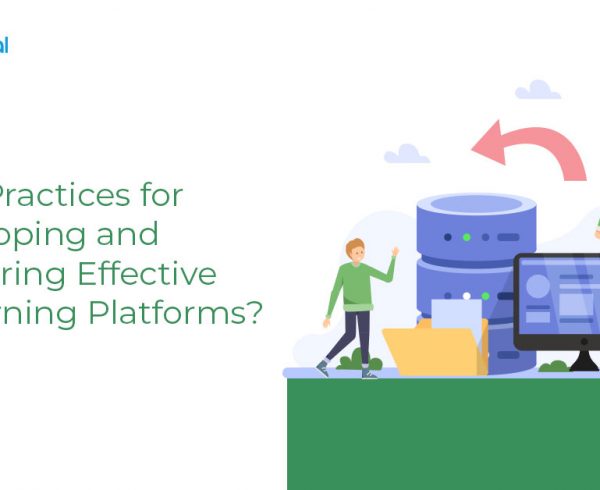With university education getting more and more expensive, online courses have come up as excellent alternatives to traditional education. Further, the ongoing pandemic has also contributed to the rapid adoption of eLearning platforms. The key driver for the growth of the industry is the demand for cost-effective and safe learning techniques in the academic sectors.
Table of Contents:
- What does this mean for Universities?
- What is an eLearning Platform & what are the various types?
- How Can Universities Build an eLearning Platform?
- Conclusion
These eLearning platforms for universities deliver training via digital devices such as smartphones, computers, and tablets without needing the students to be present in a class physically. Leading eLearning platforms today are attracting millions of users wanting to gain knowledge and acquire new skills.
What does this mean for Universities?
It simply means that it is the best time to create an eLearning platform that serves as an effective and flexible alternative for traditional learning approaches. In this blog, we’re going to explore the processes to building an eLearning platform, taking all the current trends into account.
What is an eLearning Platform & what are the various types?
Before diving into the details of how to build an eLearning platform, lets quickly discuss what an eLearning platform is and what are the various kinds.
Simply put, an eLearning platform is an online application that allows learners to deepen their knowledge in a particular area or field. The last few years have seen the eLearning market growing at a tremendous pace utilizing advanced technologies and providing users with an interactive and engaging learning experience.
To be able to build a powerful eLearning platform for universities, you first need to decide the type of platform you wish to go for. Typically an eLearning platform or website can be classified into the following types –
- Computer Managed Learning (CML) – Here, computers are used to manage and assess learning processes
- Computer-Assisted Instruction (CAI) – It uses computers along with traditional teaching
- Synchronous Online Learning – Allows students to participate in the learning process together at the same time irrespective of the place they are in
- Asynchronous Online Learning – In this type, students study independently at different times and locations, without any real-time communication taking place
- Fixed eLearning – In this mode of learning, content used during the learning process does not change from its original state, and all students receive the same information
- Adaptive eLearning – New and innovative type of learning, which makes it possible to adapt and redesign learning materials for individual learners
- Interactive Online Learning – Allows senders to become receivers and vice versa, thus effectively enabling two-way communication between the parties involved
- Collaborative Online Learning – Is a modern learning method that allows multiple students to learn and achieve their learning objectives together as a group
Also Read: Investing in the Best Online Learning Platform for Education
How Can Universities Build an eLearning Platform?
1. Identify Your Niche
The very first step in building an eLearning platform is to think about the kind of courses that will be present there. Do you wish to encompass a wide range of subjects or launch a more industry-specific education marketplace?
Some of the questions that can help you decide are –
- What subjects do you want to focus on?
- What are students more interested in – learning or improving their skill sets?
- How can you improve the skills and knowledge of learners?
- How can technology help your students learn and make subjects interactive to engage students?
- How old is your average learner, and what content might be interesting for this demographic?
2. Create the Right Model
When building an eLearning platform for universities, you should take into account multiple ways of monetizing the same before you start the development process. Some of the ways to monetize your eLearning platform include –
- Charging Per User
Charging users for a specific course is one of the most popular models used. However, it is important to note that in this type of monetization model, it is very difficult to maintain a high retention rate.
- Subscription-Based Model
Subscription-based models are often based on monthly payments or a yearly contract with a lower monthly rate. If you decide to go with this model, it is of paramount importance that you create some extra benefits for users to make them come back to your platform.
- Paid Certification Model
An increasing number of eLearning providers nowadays offer the paid certification model where they offer free courses, promoting the idea of easy access to education for everyone.
3. Use The Multimodal Content Delivery Approach
A great eLearning platform is one where users find value in what it offers. And an excellent way to create one is with relevant content.
Instead of all text or all audio content, it is best to go for a mix of various media including texts, audios, videos, slides, infographics, gamification, and more to make your eLearning platform much more effective for students.
Some of the other tips you can use to make your content more engaging include –
- Microlearning – Break the courses into bite-sized nuggets or small chunks (as short as 2-8 minutes) and focus each of them on a single objective
- Add Scenarios – Put the learners into a real-world like situation and allow them to make decisions
- Customize the modules – Separate the data based on different skills to make users feel that the course is relevant to them
- Feedback – Provide the learner with immediate feedback on the results to make them feel in complete control of the learning process
4. Regular Assessments
The eLearning platform that you build needs to make effective use of assessments to help your students track their progress and achievements. An ideal way to do this include –
- Offering tests and quizzes regularly
- Including more and more interactions when students do their assignments by adding elements such as pop-up quizzes and questions based on their previous knowledge
- Sharing assessment results and analytics or reports on students’ strengths and weaknesses with educators to help them adjust the content while also allowing learners to learn at a pace that suits them best
5. Offer An Excellent UX
A large part of the success of an eLearning platform is dependent on the usability of the eLearning space and what it looks like.
Make sure that the platform you build has interface elements that are easy to access, uses soft tones, and strategically places all the website elements. Apply minimalist design elements to your platform to help users focus only on content and learning.
Prioritizing seamless UX is important as learners will come to your platform to study, and they shouldn’t be distracted by unnecessary elements.
Also Read: Top 10 E-Learning Platforms for Effective Development
Conclusion
eLearning platforms for universities are quite complex to build and require a lot of attention. To make the most out of the platform, you need to thoroughly study your niche market to understand what software solution you can offer to your target audience. To stay ahead of the competition, your eLearning platform should offer learners the best compilation of design, content and usability.
While the above-listed steps are pivotal in building an effective online learning platform, it is equally important to strategize your business model and think from the perspective of a niche audience who will be taking up these courses and continually work on improvising the platform as per their usage and preference.
The trends in e-learning in higher education look promising. A robust digital engineering and technology solutions provider can help you decode the essentials and be better prepared. Get in touch with us to learn more or mail us








